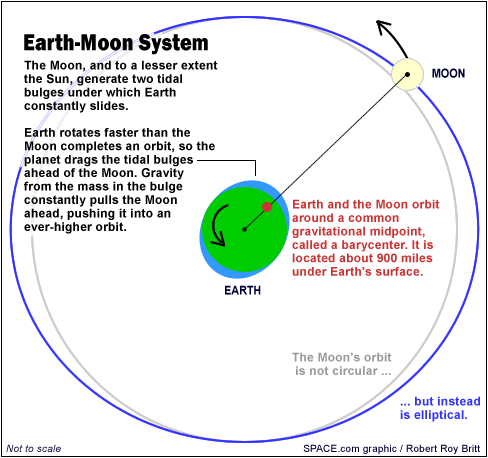Farthest Full Moon of 2010 on Tuesday Is Smallest, Too

Themoon will reach fullphase Tuesday. But as far as full moons go, it won?t be the mostimpressive. Infact, it will be the smallest full moon of the year.
About13 hours after it?sofficially full, the moon will arrive at the point in its orbitfarthest from Earth(called apogee), a distance of 252,518 miles (406,389 km). The moon?sapparentangular size that night will be at a minimum in 2010.
Thoughthe casual viewer maynot notice the difference, the Aug. 24 moon will appear 12.3 percentsmaller thanthe full moon of Jan. 30, which nearly coincided with perigee ? themoon?sclosest point in its orbit relative to Earth. [MoonMechanics]
Whenis the best time to observethe moon with a telescope?Most astronomy neophytes might say duringfull phase, but that?s probably the worst time. The moon tends to bedazzlinglybright as well as appearing one-dimensional.
Theintervals when the moonis at or just past first-quarter and last-quarter phases are when weget thebest views of the landscape right along the moon's sunrise-sunset line,orterminator. [Skywatcher?sGuide to the Moon](The terminator can also be defined as thatvariable line between the illuminated portion and the part of the mooninshadow.)
Alongwith the fact that ahalf moon offers more viewing comfort to the eye than a full moon does,we cansee a wealth of detail on its surface using a telescope with just smallopticalpower (magnifications of 20 to 40 power), or even good binoculars.Around thosetimes when the moon is half-lit or in the gibbous phase (as it will benext weekend),those features lying close to the terminator stand out in sharp, clearrelief.
Themoon was at first-quarterphase on Monday, Aug. 16 at 18:14 GMT (2:14 p.m. EDT). Thatwas the momentwhen its disk was exactly 50 percent illuminated. Lunar mountainsbecame visibleas the sun lit them from the right.
Breaking space news, the latest updates on rocket launches, skywatching events and more!
Howbright it is
Howdoes brightness of ahalf moon compare with that of full? Most would probably think it?shalf asbright, but astronomers tell us the half moon of the first quarter isonly one-eleventhas bright as full. This is due to the fact that it is heavilyshadowed, evenon its illuminated half. Believe or not, it isn?t until just 2.4 daysbeforefull that the moon actually becomes half as bright as when it?s full.
Afullmoonis almost completely illuminated, especially right around its center;the sunshines straight into all the microscopic crevices, and perhaps exceptfor aroundthe immediate edges, you will find no visible shadows at all.
Finally,have you evernoticed that when artists portray the moon, they invariably seem toshow it aseither a slender crescent or full? Half moons are shown far lessfrequently, andgibbous moons are rarely depicted at all. Ansel Adams' famousphotograph "Autumnmoon"is an outstanding exception, involving a waxing gibbous moon that Adamsimagedfrom Yosemite National Park?s Glacier Point in California back inSeptember1948.
What"gibbous"means
Theword "gibbous"is derived from the Latin word "gibbus," meaning, "hump." An unusualword to besure, but in describing the moon between half and full, it?s thecorrect term.
Thegibbous moon also is the most-seen phase, occurring for the half monthbetweenfirst and last quarter. Because it is in the sky for more than half thenight,we?re more apt to see the gibbous moon.
Infact, it is even visible during the daytime hours. That will be thecase justafter sunrise on the weekend following the full moon. In contrast, theoft-pictured crescent moon is visible only during the early evening orearlymorning hours, and sometimes only briefly.
- Top10 Amazing Moon Facts
- TheDisappearing Moon: Why and Where it Hides
- Gallery:Full Moon
JoeRao serves as an instructor and guest lecturer at New York's HaydenPlanetarium. He writes about astronomy for The New York Times and otherpublications, and he is also an on-camera meteorologist for News 12Westchester, New York.

Joe Rao is Space.com's skywatching columnist, as well as a veteran meteorologist and eclipse chaser who also serves as an instructor and guest lecturer at New York's Hayden Planetarium. He writes about astronomy for Natural History magazine, Sky & Telescope and other publications. Joe is an 8-time Emmy-nominated meteorologist who served the Putnam Valley region of New York for over 21 years. You can find him on Twitter and YouTube tracking lunar and solar eclipses, meteor showers and more. To find out Joe's latest project, visit him on Twitter.
